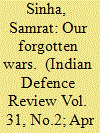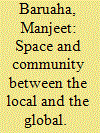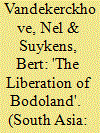|
|
|
Sort Order |
|
|
|
Items / Page
|
|
|
|
|
|
|
| Srl | Item |
| 1 |
ID:
139631


|
|
|
|
|
| Summary/Abstract |
The 2014 Lok Sabha election marks a watershed for Indian politics. The elections in the state of Assam have been marked by interethnic violence, fuelled by issues of indigeneity and ‘illegal’ migration. This paper primarily discusses the electoral result from the Kokrajhar constituency in lower Assam, the heart of Bodo politics and a hotbed for ethnic conflict. Two decades of armed struggle resulted in concessions granted to the Bodos, the largest plains tribe in Assam, in the form of a territorial council, under the Sixth Schedule of the Indian constitution. In the 2014 election, for the first time in the history of the constituency, a non-Bodo candidate won, with an impressive 51% of the vote share. The electoral outcome may be seen as a further polarization of the existing ethnic cleavage between Bodos and non-Bodos in the region. Using the theory of outbidding, it will be shown that the victory of a non-Bodo in the constituency may be seen as an outcome of a history of inter-group conflict in the region as well as intra-group rivalry among various factions of the Bodo leadership. Further, this case also illustrates that the propensity of the outbidding effect to foment inter-ethnic violence is greater in contexts where political institutions (in this case autonomous/territorial councils) encourage a singular axis of identity as a basis of mobilization. In conclusion, the paper discusses the implications of this election result for the politics of ‘ethnic homeland’ in Assam.
|
|
|
|
|
|
|
|
|
|
|
|
|
|
|
|
| 2 |
ID:
077730


|
|
|
| 3 |
ID:
146602


|
|
|
|
|
| Contents |
The humanitarian emergency which occurred in the aftermath of the 2012 violence between
Bodos and Bengali muslims (in which more than 1000 people were killed) was a crisis of immense magnitude and stretched the existing reponse mechanisms. According to the data provided by the Assam State Disaster Management Authority (ASDMA), the peak of the crisis witnessed 485,921 persons displaced (in September 2012) with 246,582 persons residing in formal relief camps. The duration of the emergency can be gauged by the fact that as of January 31, 2013, there were still 38,959 persons still residing in formal camps. These camps were ethnically segregated with Bodos and muslims residing separately.
|
|
|
|
|
|
|
|
|
|
|
|
|
|
|
|
| 4 |
ID:
103572


|
|
|
| 5 |
ID:
126658


|
|
|
|
|
| Publication |
2013.
|
| Summary/Abstract |
The objective of this article is to situate the relation between the local and the global in the context of a specific region formation, namely the Brahmaputra Valley of Assam in India as a frontier. The article takes up two examples on the relation between space and community construct and how the relation forms part of the deeper relation between the local and the global in the Valley. The Brahmaputra Valley comprises the major area of the Indian state of Assam. Assam and its neighbouring areas are also referred to as 'North East India'. The term came into use during the colonial period. It was used to refer to the British-Indian frontier which bordered on Bhutan, Tibet, China and Myanmar. In the first example of the article, the local-global relation is seen in terms of how the colonial-capitalism paradigm altered the pre-colonial socio-spatial relation, formulating and implementing new spatial and social classifications. The focus in the example is on the rearrangement of socio-spatial relations in the Valley as part of transforming a pre-colonial crossroads into a colonial frontier. In the second example, the relation between space and community construct is situated in popular responses to the above changes, and especially how international ideology like communism is appropriated to address the local specificity of frontier. The works of the cultural icon and peasant leader of the Valley, Bishnu Rabha, are discussed in detail. Through the interrelation between the two examples, the article tries to show how between the nineteenth and the mid-twentieth century the local specificity of the Valley as a frontier was possible precisely due to changes of state formation or ideology which drew on a global context. In other words, the relation between space and community construct in the Valley demonstrates how the coexistence of the local and the global was a necessary condition in its making as a frontier. Community constructs like 'tribe', 'Assamese' and 'Ahom' during the period formed part of this interrelation between the local and the global that
|
|
|
|
|
|
|
|
|
|
|
|
|
|
|
|
| 6 |
ID:
084227


|
|
|
|
|
| Publication |
2008.
|
| Summary/Abstract |
Bodoland, located in western Assam, has been a theatre for insurgencies since the mid 1980s. Too often, migration has been the paradigmatic framework to analyse not only this, but most conflicts, raging in Assam. In this article we argue that migration in itself is insufficient to understand the problems in Bodoland. Instead, we focus on forestry and tea estates, and contend that they, forming important restrictive structures, caused tribal entrapment, finally leading to violence. Moreover, we claim that during the conflict a shift in control over these structures occurred, changing the livelihood arithmetic of the involved communities. Finally, we discuss both the restraints and opportunities of the BTC/BTAD (Bodoland Territorial Council/Bodoland Territorial Administrative District)-the result of the peace process-and warn that the escape from entrapment for the Bodo could lead to the entrapment of other communities in the area.
|
|
|
|
|
|
|
|
|
|
|
|
|
|
|
|
|
|
|
|
|